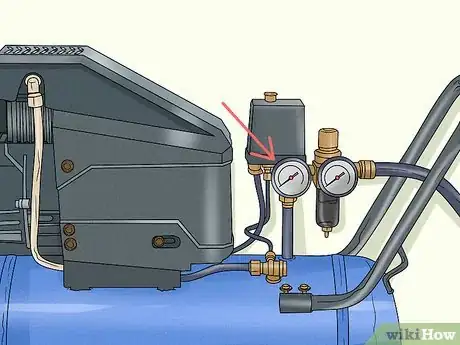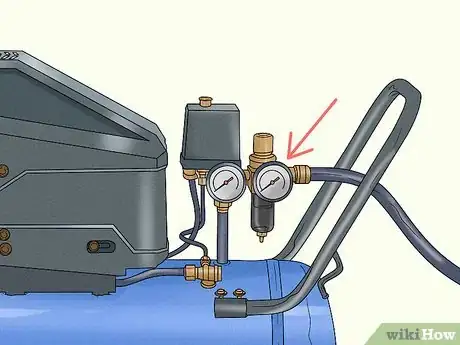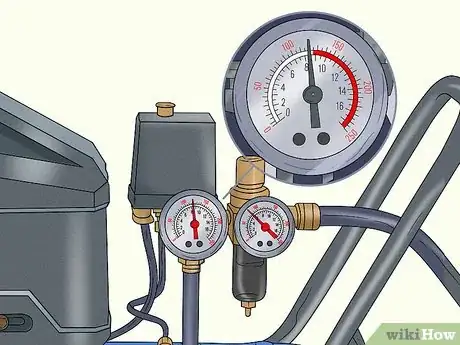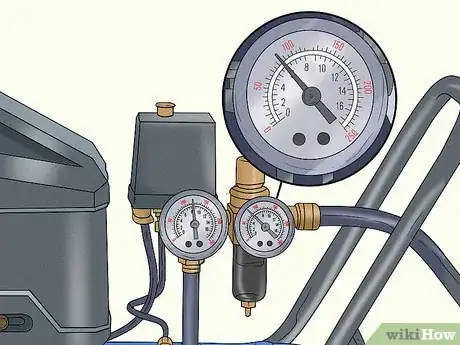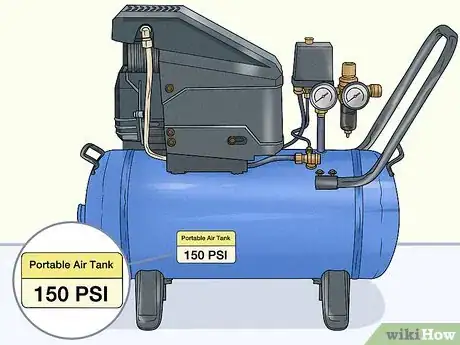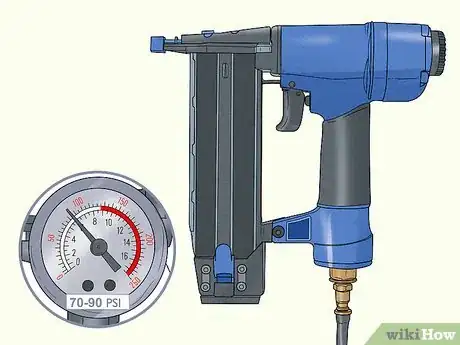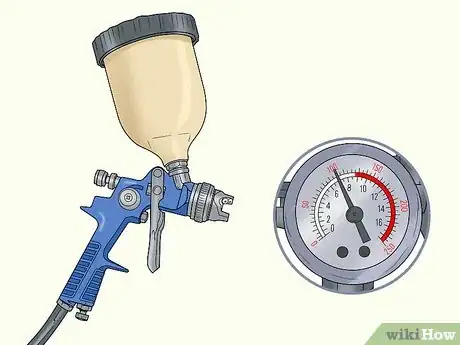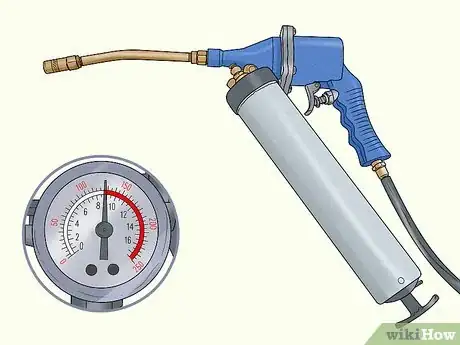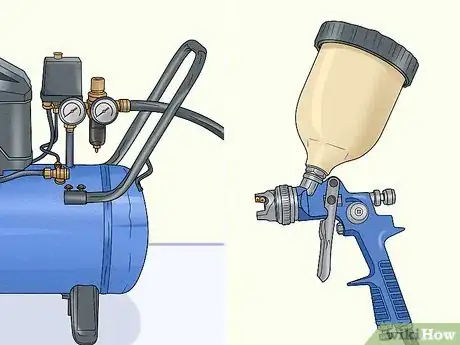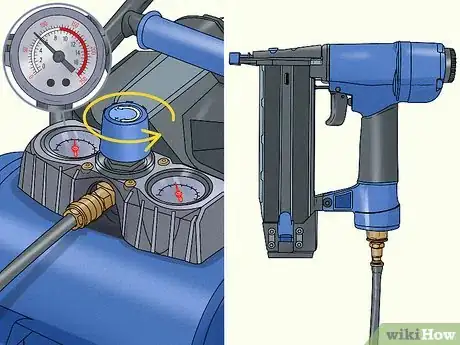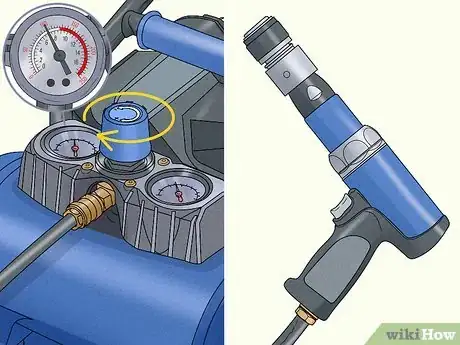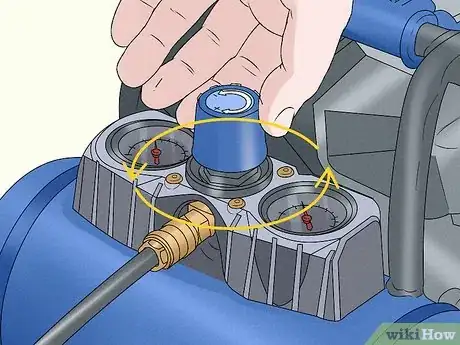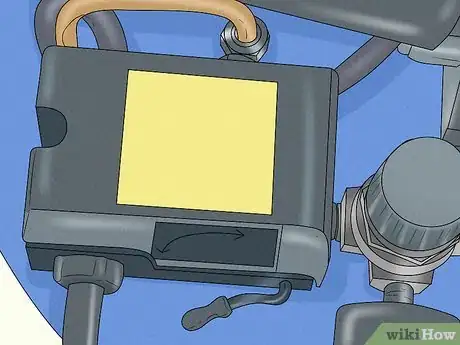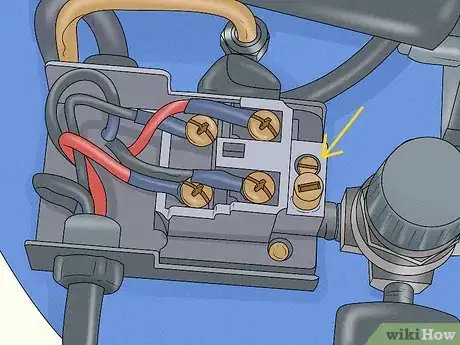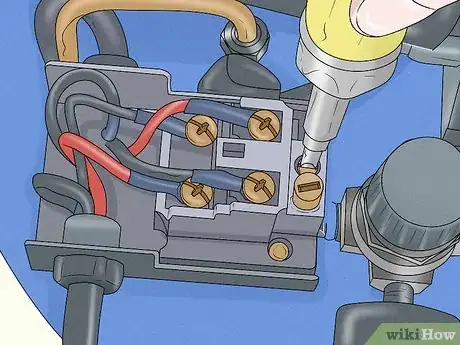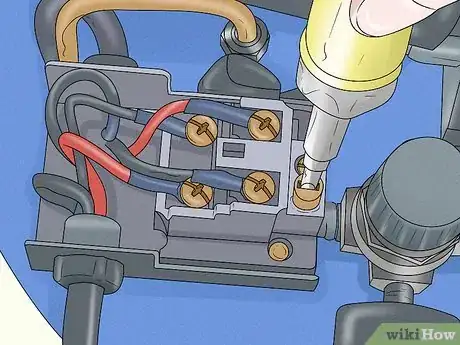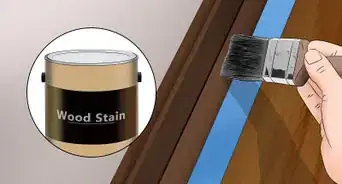This article was co-authored by Ryaan Tuttle. Ryaan Tuttle is a Home Improvement Specialist and the CEO of Best Handyman, Inc. in Boston, Massachusetts. With over 17 years of experience, he specializes in building home service businesses, focusing on creating scalable and efficient brands. With the help of his global team, the companies have achieved over 10+ million in sales and received recognition through magazine features, and enjoy partnerships with wikiHow and Jobber field service software. Boston Magazine and LocalBest.com have named Best Handyman Boston the Best Handyman in Boston. Ryaan holds Construction Supervisor and Home Improvement Contractor Licenses.
There are 10 references cited in this article, which can be found at the bottom of the page.
This article has been viewed 40,437 times.
Air compressors can be used to power all kinds of pneumatic tools, such as nail guns and other handy tools you might find yourself using to get construction and building projects done more quickly. In order for your air-powered tools to work properly, make sure to set your air compressor’s output pressure to the right PSI range. Don’t be intimidated if you aren’t sure how to do this. It’s really easy to adjust the pressure up or down using your compressor’s pressure regulator knob! Everything else, including the pressure inside the air tank, is automatically regulated by the machine's pressure switch. If you're installing a new switch, adjust the cut-in and cut-out pressures so the compressor turns on and off correctly.
Steps
Familiarizing Yourself with the Pressure Gauges
-
1Locate the air tank pressure gauge coming off of your compressor’s tank. Look at your air compressor for a gauge attached to a nozzle coming out of the air tank. This is the air tank’s pressure gauge.[1]
- This is typically the larger of the 2 gauges on an air compressor.
-
2Identify the outlet pressure gauge attached to the compressor’s airline. Find the airline, which is the hose that connects to your air tools, and look for the gauge near where the hose connects to the tank. This is the compressor’s outlet pressure gauge.[2]
- This is usually the smaller of the 2 gauges.
- The pressure regulator knob is often right below or beside this gauge where it connects to the airline, though sometimes it is in between the 2 gauges.
Advertisement -
3Look at the air tank pressure gauge to see the reserve air pressure. Check what number the needle on the air tank’s pressure gauge is pointing to. This is how much air pressure, measured in pound-force per square inch (PSI), is available in the tank for you to use. The needle will move down when you use air tools and move back up again when you stop using the air in the tank.[3]
- The reserve pressure is regulated automatically by a pre-programmed pressure switch. This keeps it within the manufacturer’s accepted range of air pressure PSI.
- Your air compressor can’t supply any more air pressure than it has in the tank and it won’t go above the maximum pressure set by the manufacturer’s pressure switch.
-
4Read the outlet pressure gauge to see the air pressure output. Take a look at the needle and read the PSI it’s pointing to. This is how much air pressure the compressor will currently supply from the reserve tank to the tool you choose to connect to the airline. The number the needle points to will change when you make adjustments to the pressure.[4]
- The outlet pressure can never be higher than the tank’s reserve pressure.
- This is the only pressure that you will need to manually set on your air compressor each time you use a different tool.
Using the Right PSI
-
1Check your air tool’s PSI requirements on the tool or in the owner’s manual. Look for a sticker or printed lettering near your tool’s handle or on its underside to see how much PSI of pressure it needs to operate. Refer to the owner’s manual if you can’t find this information on the tool itself.[5]
- Note that if your tool requires more PSI of air pressure to operate than your compressor has in its reserve tank, you can’t use that tool with your air compressor. You would have to get ahold of a bigger air compressor or find a tool that you can operate using less pressure.
- Not having enough pressure to operate a tool isn’t usually an issue because pretty much all common air tools operate within a pressure range of 70-150 PSI, which most air compressors can supply.
- Make sure you don't set the PSI above the amount needed for the tool you're using.
-
2Operate brad nailers, die grinders, and drills with 70-90 PSI. These are examples of common tools that work with pressures in a lower PSI range. Check the manufacturer’s recommended PSI for these types of tools and adjust it within this range as needed.[6]
- Orbital sanders work within a similar PSI range of 70-100 PSI.
-
3Run air hammers, angle grinders, disc sanders, and paint guns at 90-100 PSI. Many common pneumatic tools, such as these, operate in this PSI range. Always use the manufacturer’s recommended PSI setting to start with.[7]
- Other examples of air tools that work with 90-100 PSI are impact drivers, impact wrenches, ratchets, and speed saws.
-
4Utilize grease guns and tire inflators with 120-150 PSI. These are examples of air tools that operate using a higher PSI than most other tools. Remember to always set the PSI to the recommended range specified on the tool or in the owner’s manual.[8]
- A framing nailer is another type of tool that works at a higher PSI of about 100-130.
Adjusting the Pressure Regulator
-
1Set up your air compressor with the tool you want to use. Plug your chosen pneumatic tool into the air compressor’s airline hose. Plug your air compressor into a power outlet and turn it on to fill the reserve tank with compressed air.[9]
- The reserve tank will automatically stop filling when it reaches the manufacturer’s pre-set air pressure capacity.
- Always adjust the output pressure for your air compressor when you connect a new tool.
-
2Turn the pressure regulator knob counterclockwise to decrease the pressure. Look at the needle on the output pressure gauge near the air hose to determine if you need to increase or decrease the output pressure. Twist the pressure regulator knob slowly to the left until the gauge needle points to the correct PSI, if you determine you want to lower the pressure for your tool.[10]
- For example, if the output pressure gauge needle is currently pointing to 90 PSI and you are using a nail gun that needs 80 PSI to operate, turn the knob to the left until the needle points at 80 PSI on the gauge.
-
3Rotate the pressure regulator knob clockwise to increase the pressure. Check the output pressure gauge needle to see whether you need to decrease or increase the pressure. Move the pressure regulator knob slowly to the right until the needle on the gauge points to the right PSI, if you decide you must raise the pressure for your tool.[11]
- For instance, if you’re using an air hammer that needs 100 PSI to operate, and the output pressure gauge’s needle is currently at 80 PSI, turn the regulator knob to the right until the needle points to 100 PSI on the gauge.
-
4Test your tool and raise or lower the pressure if needed. Try operating your tool on something unimportant to see how it’s working at the recommended PSI, such as a scrap piece of wood if you’re using a nail gun. Turn the pressure up or down by up to 10 PSI at a time if the tool seems like it’s operating weakly or with too much pressure.[12]
- For example, if you’re using a nail gun and the nails are going too far into the wood, you can try decreasing the pressure by 10 PSI or so in order to make the nails sit flush with the surface of the wood. If the nails aren’t going in far enough, try increasing the pressure by about 10 PSI.
Changing a Pressure Switch
-
1Set the cut-in and cut-out pressures only on a new pressure switch. The cut-in pressure is the pressure at which your air compressor’s engine turns on and the cut-out pressure is the pressure at which it turns off. These pressures are automatically regulated by the factory-installed pressure switch for safety, so only set them if you are putting a replacement pressure switch on your compressor.[13]
- Do not change the cut-in and cut-out pressures on an existing manufacturer-installed pressure switch. There is no need to do this. The factory settings are there to prevent accidents.
- The cut-in and cut-out pressures ensure that your air compressor’s tank doesn’t become too pressurized and potentially explode.
- Double-check the manufacturer’s instructions for the new pressure switch to see what the factory-set cut-in and cut-out pressures are. You don’t need to make adjustments if it is set to the same range as your compressor uses.
-
2Locate the cut-in and cut-out adjustment screws on the pressure switch housing. Take the cover off the pressure switch and look for 1-2 adjustable screws. Look for labels on the switch or refer to the owner’s manual to determine which screw is for cut-in pressure and which screw is for cut-out pressure.[14]
- Some pressure switches only have 1 adjustable screw, which changes the pressure differential, or the range between the cut-in and cut-out pressures.
- Never make adjustments to these screws if you aren’t sure which is which.
-
3Turn the cut-in adjustment screw using a screwdriver to set the cut-in pressure. Rotate the screw counterclockwise to make the compressor motor turn on at a lower pressure. Turn the screw clockwise to make the motor turn on at a higher pressure.[15]
- Always refer to your compressor’s owner’s manual for the manufacturer’s recommended cut-in pressure.
- In general, the cut-in pressure should be around the lowest PSI that you operate tools at.
- If your pressure switch only has 1 pressure differential screw, turning it will automatically lower or raise both the cut-in and cut-out pressures.
-
4Twist the cut-out adjustment screw with a screwdriver to set the cut-out pressure. Turn the screw clockwise to raise the pressure at which your compressor’s motor shuts off. Rotate it counterclockwise to make the motor turn off at a lower pressure.[16]
- Always set the cut-out pressure to the manufacturer’s recommended PSI, so your compressor won’t stay on if there is too much pressure in the tank.
- In general, the cut-out pressure should be about 20-40 PSI higher than the cut-in pressure.
- If your compressor only has 1 adjustment screw, you don’t have to set the cut-out pressure. It changes automatically when you move the single pressure differential screw.
Warnings
- Always refer to the owner’s manuals for your air compressor and air tools for specific instructions regarding air pressure.[19]⧼thumbs_response⧽
Things You’ll Need
- Air compressor
- Pneumatic tool
References
- ↑ https://www.youtube.com/watch?v=tpe4prO1B7U&feature=youtu.be&t=130
- ↑ https://www.youtube.com/watch?v=tpe4prO1B7U&feature=youtu.be&t=195
- ↑ https://www.senco-emea.com/sites/default/files/Manual_PC0968_EU_20-11-2013.pdf
- ↑ https://www.senco-emea.com/sites/default/files/Manual_PC0968_EU_20-11-2013.pdf
- ↑ https://www.titusco.com/how-do-i-regulate-my-air-compressor/
- ↑ https://www.garagetooladvisor.com/air-tools/what-size-air-compressor/
- ↑ https://www.garagetooladvisor.com/air-tools/what-size-air-compressor/
- ↑ https://www.garagetooladvisor.com/air-tools/what-size-air-compressor/
- ↑ https://www.thisoldhouse.com/tools/21017350/how-to-choose-and-use-an-air-compressor
- ↑ https://www.senco-emea.com/sites/default/files/Manual_PC0968_EU_20-11-2013.pdf
- ↑ https://www.senco-emea.com/sites/default/files/Manual_PC0968_EU_20-11-2013.pdf
- ↑ https://www.prettyhandygirl.com/how-to-use-a-compressor-and-finish-nailer-tool-tutorial-friday/
- ↑ https://www.tooltally.com/how-to-adjust-air-compressor-pressure-switch/
- ↑ https://bestofmachinery.com/how-to-adjust-cut-out-pressure-on-air-compressor/
- ↑ https://www.tooltally.com/how-to-adjust-air-compressor-pressure-switch/
- ↑ https://www.tooltally.com/how-to-adjust-air-compressor-pressure-switch/
- ↑ https://www.titusco.com/how-do-i-regulate-my-air-compressor/
- ↑ https://www.rolair.com/blog/psi-cfm-article/
- ↑ https://www.senco-emea.com/sites/default/files/Manual_PC0968_EU_20-11-2013.pdf
